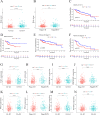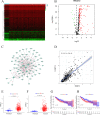Exploration and validation of a novel signature of seven necroptosis-related genes to improve the clinical outcome of hepatocellular carcinoma
- PMID: 37875823
- PMCID: PMC10594920
- DOI: 10.1186/s12885-023-11521-x
Exploration and validation of a novel signature of seven necroptosis-related genes to improve the clinical outcome of hepatocellular carcinoma
Abstract
Necroptosis has been reported to be involved in cancer progression and associated with cancer prognosis. However, the prognostic values of necroptosis-related genes (NRGs) in hepatocellular carcinoma (HCC) remain largely unknown. This study aimed to build a signature on the basis of NRGs to evaluate the prognosis of HCC patients. In this study, using bioinformatic analyses of transcriptome sequencing data of HCC (n = 370) from The Cancer Genome Atlas (TCGA) database, 63 differentially expressed NRGs between HCC and adjacent normal tissues were determined. 24 differentially expressed NRGs were found to be related with overall survival (OS). Seven optimum NRGs, determined using Lasso regression and multivariate Cox regression analysis, were used to construct a new prognostic risk signature for predicting the prognosis of HCC patients. Then survival status scatter plots and survival curves demonstrated that the prognosis of patients with high-Riskscore was worse. The prognostic value of this 7-NRG signature was validated by the International Cancer Genome Consortium (ICGC) cohort and a local cohort (Wenzhou, China). Notably, Riskscore was defined as an independent risk factor for HCC prognosis using multivariate cox regression analysis. Immune infiltration analysis suggested that higher macrophage infiltration was found in patients in the high-risk group. Finally, enhanced 7 NRGs were found in HCC tissues by immunohistochemistry. In conclusion, a novel 7-NRG prognostic risk signature is generated, which contributes to the prediction in the prognosis of HCC patients for the clinicians.
Keywords: Immune infiltration; Macrophages; Necroptosis; Prognostic signature; USP21..
© 2023. BioMed Central Ltd., part of Springer Nature.
Conflict of interest statement
The authors declare that they have no conflicts of interest.
Figures









References
-
- Dimitroulis D, Damaskos C, Valsami S, Davakis S, Garmpis N, Spartalis E, Athanasiou A, Moris D, Sakellariou S, Kykalos S, et al. From diagnosis to treatment of hepatocellular carcinoma: an epidemic problem for both developed and developing world. World J Gastroenterol. 2017;23(29):5282–94. doi: 10.3748/wjg.v23.i29.5282. - DOI - PMC - PubMed
-
- Tzartzeva K, Obi J, Rich NE, Parikh ND, Marrero JA, Yopp A, Waljee AK, Singal AG. Surveillance Imaging and Alpha Fetoprotein for Early Detection of Hepatocellular Carcinoma in patients with Cirrhosis: a Meta-analysis. Gastroenterology. 2018;154(6):1706–1718e1701. doi: 10.1053/j.gastro.2018.01.064. - DOI - PMC - PubMed
MeSH terms
Grants and funding
LinkOut - more resources
Full Text Sources
Medical

